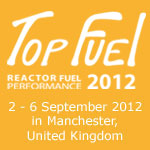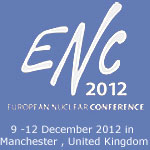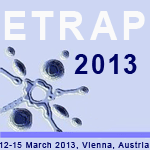
| |
In his opening address, Luc Oursel, CEO of AREVA and President of SFEN, emphasised how the nuclear science community must benefit from the credibility that it has with the public and communicate science effectively in order to dissipate the fears of citizens that have intensified since Fukushima. It must also underline how the fundamental safety of the French nuclear industry has been endorsed following the rigorous stress tests procedure and dispel the inaccurate and partisan view that Fukushima has somehow “spelled the end for nuclear energy.” The first speaker to address the delegates was Akira Omoto, Commissioner of JAEC (the Japanese Atomic Energy Commission). He provided a detailed status update of on-site and off-site remedial action that has been taken - and is still being taken - in Japan. This includes the severe accident analysis that JAEC has carried out, analysis of reactor pressure level containment, the prevention of residual heat damage, the removal of caesium, the monitoring of |
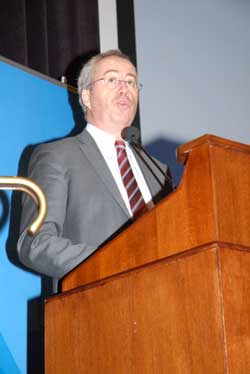 |
radiation spill-over into the ocean and the issue of the radioprotection of employees. JAEC also coordinated with the local authorities the work that was carried out to decontaminate residential areas.
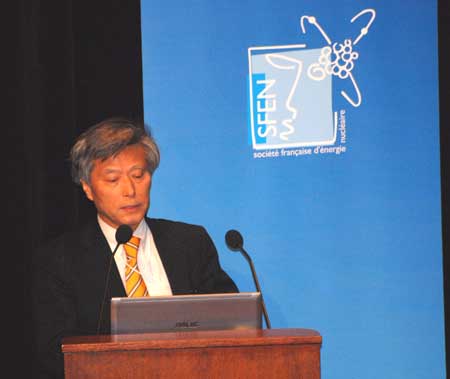
Mr. Omoto stated that 27 lessons had been learned from the accident. Among these were the need for enhanced design to increase resistance to natural disasters (including a “tsunami probabilistic hazard study”), increased black-out prevention, improved severe accident management capability, improved education and training for nuclear engineers and increased communication with the public.
After Japan, the attention switched to France. Dominique Minière, Director of EDF’s Nuclear Production Division, outlined the complementary safety evaluations (ECS) that EDF is carrying out at France’s nuclear power plants at the request of the ASN, France’s national regulatory authority. These evaluations are in addition to the standard ten-yearly reviews (“revues décénnales”) required by law and concentrate primarily on robustness of design, crisis management capability, resistance to natural disasters, the prevention of loss of power and heat sink and exceeding current reference levels.
Mr. Minière also gave an overview of the role and modus operandi of the FARN (Rapid Nuclear Action Force), the rapid intervention force that would intervene in France in the event of a nuclear accident.
Philippe Knoche, a member of the Board of Directors of AREVA then presented the latest information about the ECS carried at by AREVA in response to Fukushima. Complementary testing at AREVA facilities was carried out both within and beyond accepted reference levels, with special emphasis on controlling the temperature of spent fuel pools and the critical cooling of reactor chambers under extreme circumstances. AREVA has decided that safety at all its handling and storage facilities will be enhanced as of 2013. A total of 120 million Euros will be invested in further studies, especially additional seismological analysis and earthquake protection measures. All plants that do not conform to the new reference levels will be upgraded.
The lessons to be learned from Fukushima, inevitably, provided an added political dimension to the Annual Convention, as witnessed by the presence of France’s Prime Minister, François Fillon. Mr. Fillon delivered a lengthy speech extolling the virtues of nuclear energy as a vital component of France’s economy and of Europe’s low-carbon energy future. After reiterating France’s total support and solidarity for Japan following the accident, Mr. Fillon stressed “the historic and strategic commitment that has enabled France to develop its industry into what it is today” - an industry that provides 78% of France’s electricity output, employs almost 500,000 people and is a considerable economic asset for the nation. He dismissed the notion of withdrawing from nuclear energy as “an aberration”, “absurd” and “nonsensical”, and added that extending the operational lifetime of France’s nuclear power plants would be an “expensive but necessary investment.”
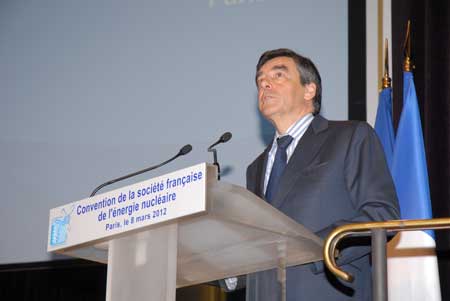
After this laudation of nuclear energy, AREVA and EDF joined forces to present a detailed safety analysis of the EPR. Bertrand de l’Epinois, Director of Safety Standards at AREVA and Jean-Luc Forêt, Deputy Director of EDF’s Nuclear Engineering Division (CNEN), stressed how the EPR’s enormous water reserves and supplementary back-up cooling measures make it particularly well designed to ensure critical cooling in the event of an accident. Similarly, EPRs have two different kinds of diesel generators at their disposal, housed in two different buildings, in order to ensure back-up power at all times. The EPR is also equipped with advanced depressurisation and residual heat evacuation functions and its design concept prevents the likelihood of a hydrogen explosion occurring. Nevertheless, in spite of the EPR’s excellent safety profile, certain modifications to the reactor at Flamanville will be made in response to Fukushima.
The next speaker was Laurent Stricker, Chairman of the World Association of Nuclear Operators (WANO), whose mission is to help maximise safety and operational performance at all nuclear power plants worldwide. Mr. Stricker stressed the collective responsibility of operators, stipulating that individual responsibility lies at the national level and collective responsibility at the international level. Following Fukushima, WANO has extended its scope from “prevention” to “prevention and mitigation” and has put forward a number of recommendations for operators, including improving real-time communications, upgrading emergency response plans and carrying out regular peer reviews.
Next it was the turn of the regulatory authorities to provide their expert analysis of the ECS and of the need to redefine safety reference levels. Sophie Mourlon, Deputy Director General of ASN and Caroline Lavarenne, Deputy Head of Systems and Risks at the IRSN (France’s National Institute for Radioprotection and Nuclear Safety), focused on the ECS that have been carried out at 150 nuclear facilities in France. Ms. Mourlon highlighted the main conclusions drawn by the ASN in a report they have published on the tests carried out by EDF and AREVA. Among the conclusions that the ASN and the IRSN reached was the fact that while most facilities satisfy accepted safety and radioprotection reference levels, it remains to be seen whether they will be able to cope with “beyond reference level” scenarios. Only once such scenarios have been taken into account will nuclear installations be better equipped to safeguard against future accidents like Fukushima.
Bernard Bigot, Managing Director of the CEA, France’s Commission for Atomic and Alternative Energies, emphasised how nuclear energy is an essential component of Europe’s future energy mix and a catalyst for global growth and development. He articulated a number of key messages during this presentation. One of these was that we must learn from the lessons of Fukushima by increasing our investment in research. Another was that the key to securing the future of nuclear energy is to increase public confidence in nuclear and that science and research, which the public generally trust, can help achieve this.
Day 1 concluded with a panel discussion on nuclear safety after Fukushima. The panel members were Philippe Jamet, Commissioner of the ASN; Laurent Stricker, Chairman of WANO; Christophe Behar, Director of Nuclear Energy at the CEA; Jean-Marc Miraucourt, Director of Engineering at France’s Nuclear Fleet Division and Jean Van Vyve, Director of Nuclear Production at Electrabel/GDF Suez. The panel reflected upon what had been discussed during the day, focusing in particular on further prevention and mitigation measures, on how to put the lessons of Fukushima into action, on the need for specific crisis management centres at all NPPs in France and on further upgrading existing emergency response procedures.
Day 2
Day 2 kicked off with an in-depth analysis of Germany’s decision to phase-out nuclear energy and the consequences that this will have - not just for Germany but for its neighbours and Europe as a whole. Eberhard von Rottenburg, from BDI (the Germany Federation of Industries) gave a very candid appraisal of the German phase-out decision. He stressed that the decision, which was based more on political than on sound economic and technical considerations, has forced up electricity prices in Germany and in neighbouring countries. He outlined how replacing nuclear with renewables in Germany just won’t work and that the stability of the country’s energy provision is under threat because of the intermittent nature of renewables. In addition to raising prices, Germany’s nuclear phase-out strategy will bring extra risks, including loss of energy security and independence (Germany has gone from being a net exporter of energy to a net importer) and the increased likelihood that Germany will not be able to meet its CO2 reduction commitments. Mr. von Rottenburg concluded by saying that in the view of the BDI the decision to phase-out nuclear was a mistake and has seriously compromised the country’s energy future.
From Germany the spotlight then switched to China. Wei Lu, the General Representative of CGNPC (the China Guangdong Nuclear Power Company) in Europe, outlined China’s ambitious nuclear programme, which is experiencing rapid expansion. Following Fukushima, China carried out a comprehensive safety audit at all of its nuclear facilities. It called a temporary halt to its new build projects and a review of the country’s long-term nuclear plan was undertaken in parallel with the upgrading of its national safety plan. However, China remains committed to nuclear and sees it as a safe, clean and sustainable energy source. The construction of 26 units there (a mixture of EPRs, AP1000s and other reactor types) has resumed and extensive R&D is being carried out into Generation III and Generation IV reactors. He reiterated a common mantra recited during the Annual Convention, namely that nuclear will not progress further unless the lessons of Fukushima are learned.
The US was the next country to occupy centre stage. James Spina, Vice-President for Corporate Site Operations at Constellation Energy Group (CENG), in the US, outlined the current status and future prospects for nuclear energy in his country. The US is no stranger to the devastating effects of natural disasters, having experienced numerous floods and earthquakes in recent years. Bodies like INPO (the Institute of Nuclear Power Operators) have accumulated considerable expertise in operating nuclear power plants and maintaining safety levels under extreme circumstances. Nevertheless, the US is further upgrading its seismological expertise, reviewing its safety measures and procedures and upgrading its communications and outreach strategy.
Jacques Percebois, Director of CREDEN (the Centre for Economic and Energy Research of the University of Montpellier, France), then presented the recommendations of the Energy Commission 2050, which was set up to analyse France’s energy prospects and needs for 2050. Mr. Percebois gave special emphasis to the conclusions that the Energy Commission 2050 report draws on the future role of nuclear energy in France.
He highlighted the four nuclear scenarios put forward in the report: an accelerated route to Generation III and Generation IV reactors, the extension of the operational lifetime of the existing fleet, the progressive reduction of nuclear and the total withdrawal from nuclear when the reactors are forty years old. Mr. Percebois stated that the future composition of France’s energy mix is uncertain and that a horizon of 2030 was a more realistic option than 2050 when calculating France’s future energy needs. In 2030, fossil fuels will still account for 75% of France’s total energy output and nuclear will remain a vital component of the energy mix because of its low-carbon profile. Mr. Percebois, also stressed that nuclear is a competitive energy source that contributes significantly to the French economy and enables France to reduce its gas imports.
Another focus of CREDEN’s work has been the analysis of the recent report into the costs of generating electricity that the Court of Accounts in France has carried out. The report established that the cost of nuclear is 54 Euros/MWh and also analysed the cost of CO2 emissions. One notable conclusion drawn by the Energy Commission 2050 was that the average overall cost of energy in Europe will rise when Germany completely shuts down its nuclear facilities in 2022.
Yves Giraud, Director of Economy of Production and Industrial Strategy at EDF, then gave an overview of the efficiency of EDF’s electricity generation systems and distribution networks. He highlighted how the recent extreme cold temperatures in France illustrated clearly the vital role of nuclear energy in maintaining sufficient base-load energy. He went on to echo the earlier words of Prime Minister François Fillon by stressing that because of nuclear energy’s vital security of supply and climate change credentials, and its important role as an employer (it has created 240,000 direct jobs in France), withdrawing from nuclear in France would be out of question - “it would be like Germany closing down its car manufacturing industry.”
Hervé Mignon, Director of Economy, Research and Transparency at RTE (France’s Electricity Transport Network), outlined the vital role that his organisation plays in ensuring that industry and consumers receive their electricity. Over the last ten years France’s electricity transport network has increased by 10%. The cost of transport has risen and now accounts for 10% of consumers’ electricity bills. He also focused on how the transport sector must meet the significant capacity and logistical challenges it is facing today, like the impact of weather conditions, the increase in the number of wind turbines in France since 2005 (providing an extra 1 GWh/year) and the growth of the photovoltaic sector, which now provides 2GW of installed capacity.
Dr. Tim Stone, Expert Chair at the UK government’s Department of Energy and Climate Change (DECC) and Senior Advisor to the Secretary of State for Energy, gave a status update on the UK’s ambitious nuclear new build programme.
The programme includes the building of 10-13 reactors that will provide an extra
16 GW of electricity. He stressed that nuclear energy, renewables and carbon capture and sequestration (CCS) are the core components of the UK’s energy plan.
Legislation resulting from the UK’s energy reform is close to being finalised. Among the main elements of the reform are the setting of a floor for carbon prices, a fixed emissions performance standard, a boost for low-carbon methods of generation and the establishing of a market-wide capacity. The UK government is also, placing great importance on investment incentives, increased training and skills recruitment and low regulatory risk in order not to deter potential investors.
He concluded by saying that public opinion in favour of nuclear energy and new build in the UK is actually higher now that it was before Fukushima.
Laura Cozzi, Deputy Head and Principal Analyst from the Office of the Chief Economist of the IEA (International Energy Agency), then spoke about the IEA’s World Energy Outlook report for 2011. The focus of her presentation was climate change imperatives and global energy needs over the next 25 years. She drew special attention to rapidly developing countries like India and China and highlighted the urgent priority of reducing CO2 emissions to avoid a projected increase in global temperatures over the study period of 6°C. According to the IEA, the solution is a combination of appropriate political choices and the use of all available low-carbon technologies, including nuclear.
Next up on stage was Boris Stupiot, President of France’s Young Generation Network (YGN). He briefly outlined the vital role and important contribution that young engineers and employees with a broad range of skills are making - and will continue to make - to the future of the nuclear sector, not just in France but worldwide.
The final topic to be discussed at the Annual Convention was public acceptance, an important vector for change. François Ewald, who is a Professor at the National Conservatory for Arts and Crafts in France and President of AREVA’s Scientific and Ethical Committee, examined the issue of public acceptance and risk perception. He stressed that after the initial shock of Fukushima public opinion in favour of nuclear energy was not affected much. In his view this was because the French public made the important distinction between what is necessary and what is superfluous and judged pragmatically that because energy is necessary France needs a robust and reliable source of energy, like nuclear. For once economic risk took precedence over environmental risk, which explains why confidence in nuclear did not significantly decrease after Fukushima.
The final session of the Annual Convention was a panel discussion on the subject of public acceptance. The panel consisted of Brice Teinturier, Deputy CEO of IPSOS France; Philippe Girault, Partner of Price Waterhouse Coopers Advisory, Michel Chevalet, a scientific journalist and Michel Laurent, President of the Flamanville Local Information Committee.
The panel examined the major concerns that the public has with nuclear, in particular the potential risks that it poses to human health and the environment and the problem of waste. Other factors that tend to positively influence public opinion include reducing CO2 emissions and the important social benefit that nuclear brings in terms of jobs and economic development.
Among the conclusions reached by the panel was the fact that in France there has been no general demonization of nuclear energy. The minimal change in public acceptance that occurred after Fukushima supports this thesis, as does the belief among a majority of French citizens (66%) that nuclear is safe. Stakeholder involvement, perceived transparency and the responsibility of the industry to communicate openly are considered to be additional factors influencing public opinion in France. Overall the image of the nuclear sector in France is a positive one – it is safe, necessary, profitable and generates employment. Most citizens are pragmatic and think that abandoning nuclear is not an option.
In his concluding remarks, Dominique Minière, Director of EDF’s Nuclear Production Division, reflected on an extremely successful Annual Convention – successful because of the programme content, because of the quality of the speakers and because of the intensity of the debate. He then focused primarily on the lessons to be learned from Fukushima, placing the accident within the context of the history of nuclear safety, which began with Three Mile Island and was followed by Chernobyl. He emphasised that if Three Mile Island highlighted the importance of human error and Chernobyl led to the instilling of a culture of safety at nuclear installations, one of the fundamental lessons to be learned from Fukushima is that long-term contamination of the land after a nuclear accident is unacceptable. Consequently, nuclear plant designers, utilities and nuclear regulators must do all in their power to ensure that this does not occur in the future. It is with this in mind that EDF is working on creating the FARN (Force d’Action Rapide Nucléaire, or “Rapid Nuclear Action Force”). The only kind of safety that is acceptable, Mr. Minière concluded, is one that is continually evolving and improving. The role of the SFEN is not only to inform and enlighten its members but also to constantly question them, “…because the nuclear community never performs better when it comes to safety than when it is constantly questioning itself.”
Throughout the Annual Convention delegates took an active part in the lengthy and often passionate debates that followed the various sessions. The quality of the speakers, the broad-ranging programme, excellent conference facilities and the committed involvement of those who participated, contributed to what was a fascinating and highly informative event.
The presentations made at the SFEN 2012 Annual Convention can be consulted on SFEN’s website at: https://www.sfen.fr/8-9-mars-2012/Presentations .
Editor-in-Chief, ENS NEWS
